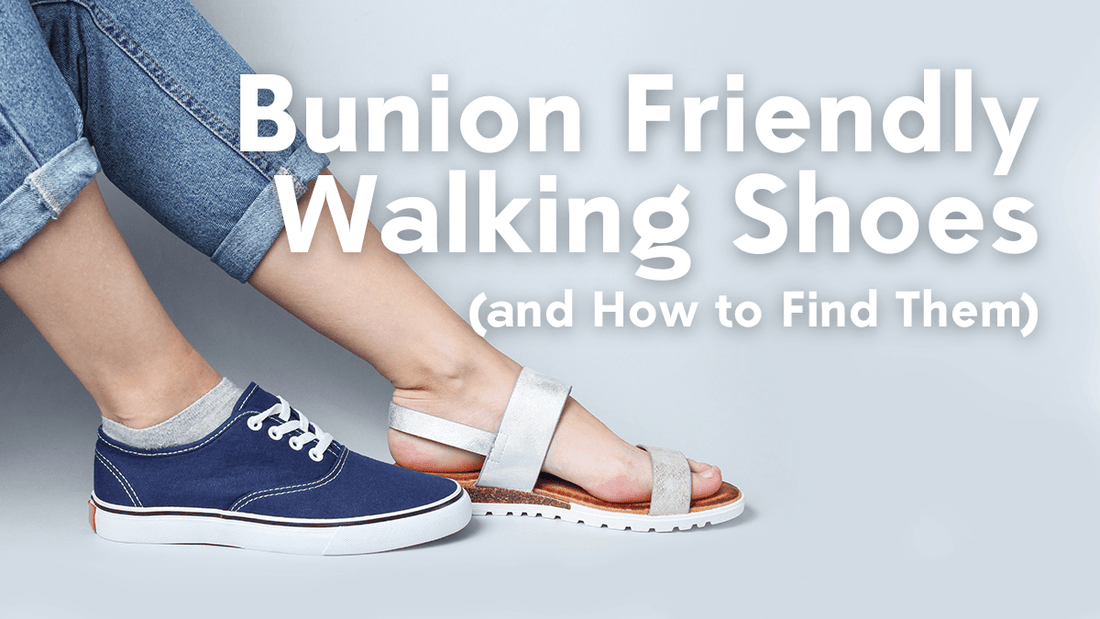Bunion Friendly Walking Shoes (and How to Find Them)
- Bunion Friendly Shoes
- Bunions
- Healthy Feet
- Pain Relief

Welcome back to our four part series on how to soothe your bunions. In part one of this series, we examined the importance of wearing the right shoes. Today, we’ll dive deeper into this question and explore the best bunion friendly walking shoes to soothe tired feet.
There are so many different walking shoes on the market today. Sometimes it can become difficult and a little overwhelming to know which is the best shoe for you and your specific needs. Fortunately, as long as you know what features to look for in a walking shoe, you will be able to find the ideal walking shoe for YOU.
A wide toe box is a must for any person that has a bunion deformity. If you have trouble finding wide toed shoes in the store, they are readily available online. This is a great option if all of the other features of the shoe fit your feet perfectly and the only additional accommodation you need is a wider toe box.

A mesh upper is one of my favorite features in a walking shoe. Not only does it accommodate bunion deformities of the great toe, the mesh upper also accommodates bunionettes (a bunion of the fifth toe). It is common for people with flatfeet to have both bunions of the great toe and fifth toe due to the hypermobility of the foot. The breathable mesh fabric accommodates the bunion deformity, thereby decreasing pain and preventing skin irritation and blister formation. If you currently wear a gel type bunion pad (or are considering wearing one) a walking shoe with a wide toe box and the breathable mesh fabric will give you the additional room needed in the front of your shoe to accommodate the extra padding.
If you have a bunion caused by a flatfoot, look for a walking shoe that states it’s for an “overpronator.” This is essentially the degree to which the arch of your foot collapses upon weight bearing. In an overpronator, the arch collapses excessively leading to hypermobility. One simple way to gauge if you are an “overpronator” is to look at the wear pattern on the bottom of your shoes. If you see excessive wear from the heel, along the inner side of the shoe and to the great toe, you likely are over-pronating. If you are unsure just make an appointment with your podiatrist. Making sure you are wearing a shoe with the proper level of stability for your foot is essential to your overall foot health.
Lastly, if you are a diabetic patient with a bunion deformity, you should schedule an appointment with your podiatrist to be fitted for a pair of diabetic walking shoes. Diabetic walking shoes have seam- free interiors to prevent skin irritation and skin breakdown that can lead to ulcer formation especially at prominent bony deformities such as a bunion. Most insurances will cover the cost of the shoes and you will also be dispensed three pairs of inserts for the year. If you have a large bunion deformity, hammertoes or other findings such as poor vascular flow to the feet you may actually qualify for custom inserts. Your feet will also be measured in the office so you don’t have to worry about ordering the wrong size.
As you can see, there are a wide variety of shoe options, depending on the reason for your bunion formation. In part three of our series, we’ll explore other nonsurgical ways of finding relief from bunions.
Author: Dr. Megan Ziemer, DPM
Wondering if you have a bunion? Check out our bunion quiz for more information and relief tips!
Continue Reading
View All
Our New Copper Infused Elbow Sleeve
We are so excited to introduce our new Copper Elbow Sleeve. Watch this short video to learn why this is the best cho...
- Joint Pain
- Pain Relief
Get the Heel Outta Here: Causes & At-Home Treatment for Dry, Cracked Heels
Heel fissures cause dry, cracked heels that can lead to pain and discomfort. Learn the causes of yellow, crusty heels...
- Dry Cracked Heels
- Healthy Feet
- Heel Pain
31 Reasons to Make Compression Gloves Your Soulmate
If you have hand pain, your soulmate might be a pair of compression gloves. Support, compression, copper compression ...
- Arthritis
- Carpal Tunnel
- Hand Pain
- Pain Relief